Deciding what muscle groups to workout together can be confusing.
Some say workouts for muscle groups that function together are best, citing the popular pairing of chest and triceps as an obvious example.
Others say workouts for muscle groups that oppose each other make more sense since this ensures you don’t “carry” fatigue from one exercise into the next and can train harder as a result.
Still others say there’s no such thing as the best muscle group combinations to workout together. Instead, your resistance training workouts should revolve around a single exercise, such as the squat, bench press, or deadlift.
In truth, all of these stances are wrong—there are no “best” muscle groups to workout together. How you structure your strength training program largely depends on how much time you have to train and how quickly you recover.
In this article, you’ll learn what muscle groups to work together based on your preferences, the best exercises for each major muscle group, how to put this information into practice, and more.
Key Takeaways
- A “muscle group” is a collection of muscles situated close to one another that work together to perform a specific movement or function.
- In strength training, the six major muscle groups are the chest, back, shoulders, legs, arms, and core.
- Deciding what muscle groups to workout together mostly depends on how many times per week you can train and how well you recover.
- To support recovery and get better results from your training, consider using a high-quality protein powder to help you reach your daily protein target, creatine to support recovery and muscle growth, and a pre-workout to enhance energy, focus, and performance.
Want to know exactly how you should train to reach your fitness goals? Take our 60-second quiz and learn exactly how often you should train, what exercises and how many sets and reps you should do, and more.
What Are the Major Muscle Groups?
A “muscle group” is a collection of muscles situated close to one another that work together to perform a specific movement or function.
In the context of strength training, there are six major muscle groups:
Categorizing the muscles in your body like this helps you better organize and prioritize your training. It also allows you to decide the best muscle groups to workout together to maximize your progress.
Major Muscle Group #1: Chest
The main muscle of the chest is the pectoralis major, or “pec” major.
Here’s how the pecs look:
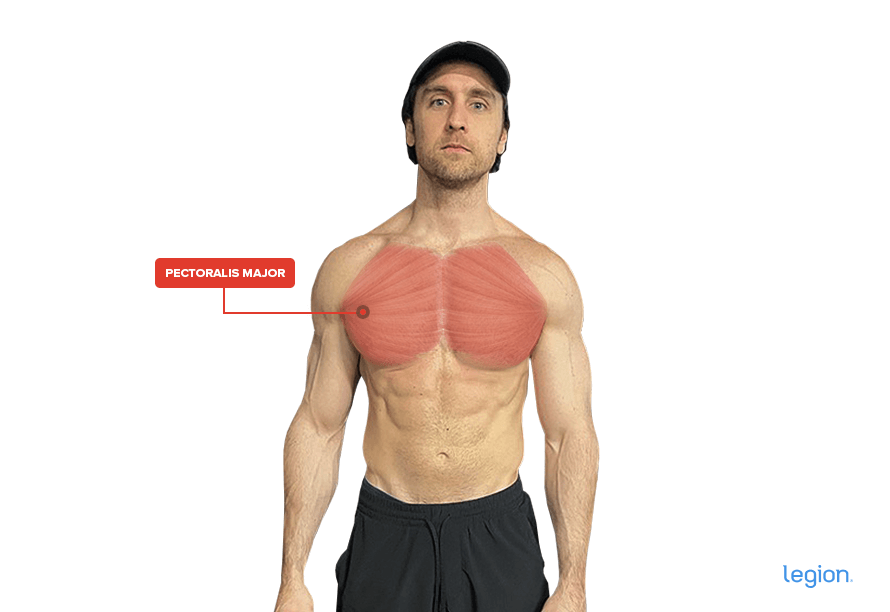
Major Muscle Group #2: Back
Multiple muscles make up the back, but the main ones are:
- Trapezius (traps)
- Rhomboids
- Latissimus dorsi (lats)
- Erector spinae
- Teres major and minor
- Infraspinatus
Here’s how they look:
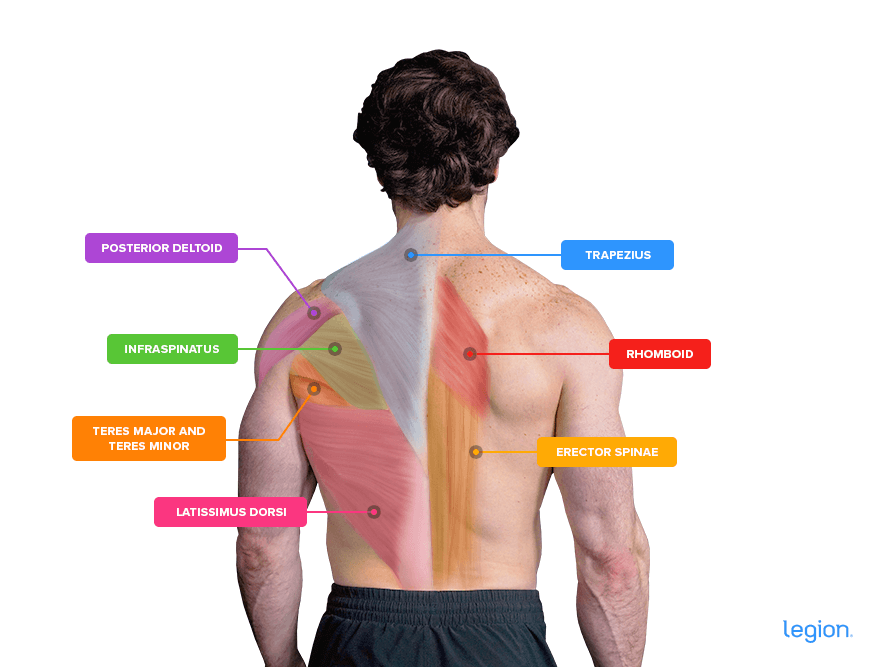
Major Muscle Group #3: Shoulders
Your deltoids, or “shoulder muscles,” have three sections or “heads:” the anterior deltoid (“front delt”), the lateral deltoid (“side delt”), and the posterior deltoid (“rear delt”).
Here’s how they look:
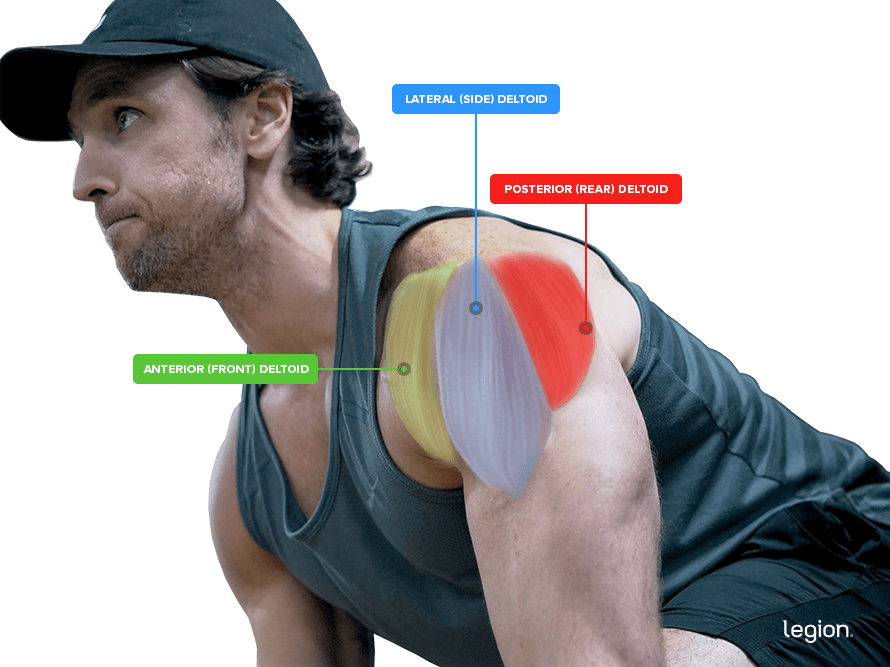
Major Muscle Group #4: Legs
The upper legs comprise three muscle groups:
The only muscle group in the lower legs is the calves.
Here’s how these muscles look:
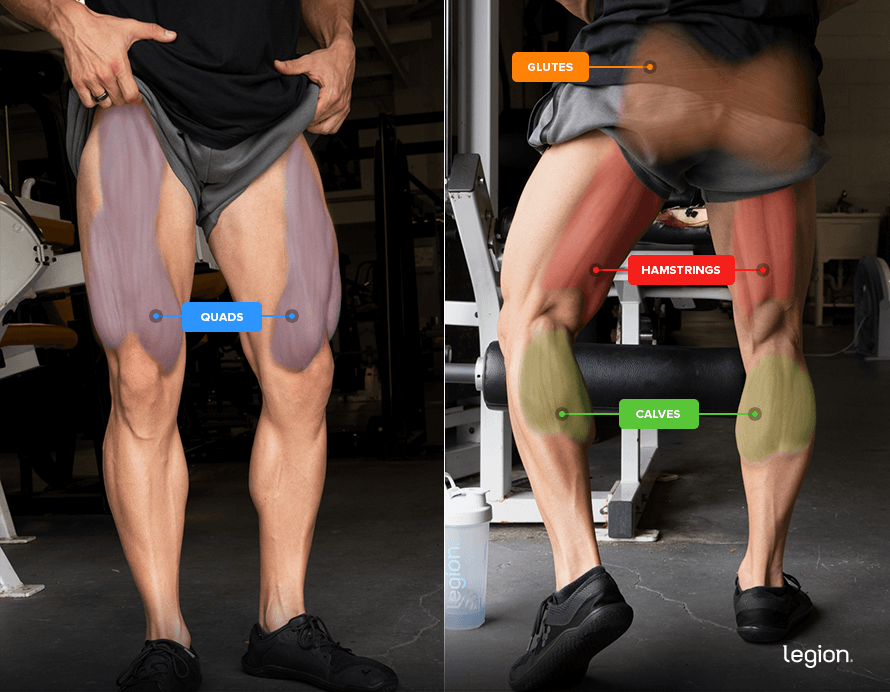
Major Muscle Group #5: Arms
Four primary muscles make up the arms:
- Biceps brachii
- Biceps brachialis
- Triceps brachii
- Forearms
Here’s how they look:
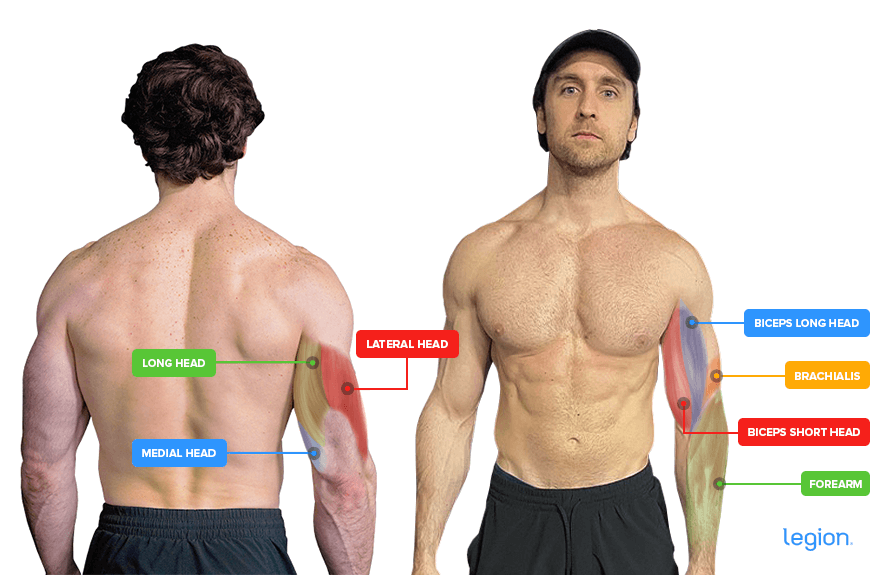
Major Muscle Group #6: Core
Your “core” is the group of muscles around your midsection. The main core muscles are the rectus abdominis and the internal and external obliques.
Here’s how they look:
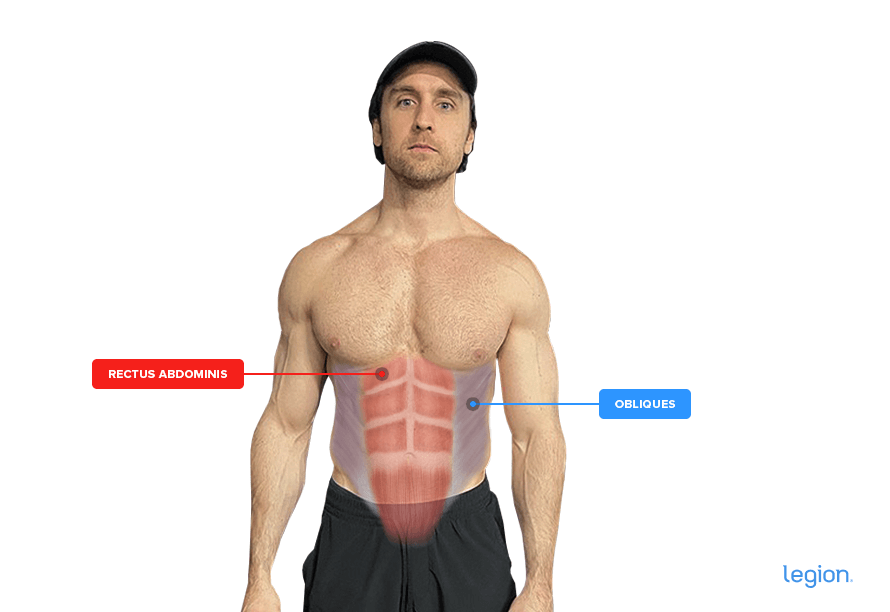
The Best Muscle Groups to Workout Together
Deciding what muscle groups to workout together largely comes down how many times per week you can train and how well you recover.
Here’s a straightforward guide to the best muscle group combinations to workout together, depending on whether you’re training 3, 4, or 5 days weekly.
The Legion 5-Day Workout Routine
The following workout schedule is ideal for building muscle mass and gaining strength.
It contains the perfect mix of volume, intensity, and frequency to drive progress while still allowing plenty of time for recovery.
What’s more, it only involves training on weekdays, and you should be able to complete each session in under an hour, so it’s practical and easy to follow for most.
The only potential downsides are that it demands a significant weekly time commitment and is more intense than many other routines, which means you’ll need to focus more on recovery.
However, provided you can dedicate the time and manage recovery well (avoid excessive fatigue, stress, and injury), this plan will produce excellent results.
Here’s the schedule:
- Day 1: Push
- Day 2: Pull & Calves
- Day 3: Upper Body & Core
- Day 4: Legs
- Day 5: Upper Body & Core
The Legion 4-Day Workout Routine
If you can’t commit to training five days per week or need more time to recover from your workouts, this 4-day schedule is a fantastic solution:
- Day 1: Push & Core
- Day 2: Pull & Calves
- Day 3: Upper Body & Core
- Day 4: Legs
The Legion 3-Day Workout Routine
The three-day routine is almost identical to a traditional push pull legs routine, except with more isolation work to bring up stubborn muscle groups like the shoulders.
It’s a great choice for beginners who want to ease into strength training, people who find training more often causes recovery issues, or those who are pressed for time:
- Day 1: Push & Core
- Day 2: Pull & Calves
- Day 3: Legs
If you’d like to give these routines a whirl, just enter your email address in the form below, and I’ll send you 12 weeks’ worth of workout programming, including exactly what exercises to do and how many reps and sets you should do for each exercise.
Now that you know what muscle groups to workout together, let’s look at what exercises you should use to train them.
The Best Exercises to Workout Each Muscle Group
You now know the best muscle group combinations to workout together for your circumstances. Now let’s look at the best exercises for training each muscle group:
Chest Exercises
To develop a full, proportionate, well-defined chest, focus on the following chest exercises:
- Bench Press
- Incline Bench Press
- Dumbbell Bench Press
- Incline Dumbbell Bench Press
- Dip
- Push-up
- Machine Chest Press
And for five evidence-based chest workouts, check out this article:
The 5 Best Chest Workout Routines for Mass & Hypertrophy
Back Exercises
To develop a wide, thick, defined back, focus on the following:
- Deadlift (Conventional, Sumo, and Trap-Bar)
- Pull-up
- Chin-up
- Barbell Row
- One-Arm Dumbbell Row
- Cable Row
- T-Bar Row
- Lat Pulldown
- Machine Row
For the best science-based back workout for mass, check out this article:
The Best Back Workouts for Mass & Hypertrophy
Shoulder Exercises
To develop proportional, “capped” delts, focus on shoulder exercises, such as:
- Standing Overhead Press
- Seated Overhead Press
- Shoulder Press
- Arnold Press
- Dumbbell Side Lateral Raise
- Cable Side Lateral Raise
- Dumbbell Rear Lateral Raise
- Barbell Rear Delt Row
For a full shoulder workout for “3D” delts, check out this article:
The Best Shoulder Workouts for Men, According to Science
Leg Exercises
To develop each lower body muscle group, focus on the following:
- The Quads: Back squat, front squat, Bulgarian split squat, lunge, leg press, and hack squat.
- The Hamstrings: Deadlift, Romanian deadlift, good morning, leg curl, glute-ham raise, and Nordic hamstring curl.
- The Glutes: Deadlift, back squat, front squat, Romanian deadlift, hip thrust, reverse lunge, step-up, Bulgarian split squat, and glute bridge.
- The Calves: Seated calf raise, standing calf raise, leg press calf raise, and donkey calf raise.
For a science-based workout that trains your entire lower body, check out this article:
The Best Leg Workout Routine for Building Mass & Hypertrophy
Arm Exercises
To develop each of the muscle groups in the arms, focus on the following:
- Biceps Brachii: Chin-up, pull-up, lat pulldown, dumbbell biceps curl, barbell biceps curl, incline dumbbell curl, and preacher curl.
- Biceps Brachialis: Neutral-grip pull-up and hammer curl.
- Triceps Brachii: Close-grip bench press, dip, JM press, skullcrusher, overhead triceps extension, and triceps pushdown.
- Forearms: Deadlift, Romanian deadlift, barbell row, one-arm dumbbell row, dead hang, plate pinch, and Zottman curl.
For an arm workout containing all the best arm exercises, check out this article:
The Best Arm Workouts for Building Mass
Ab Exercises
To make your six-pack “pop,” focus on these core exercises:
- Cable Crunch
- Captain’s Chair Leg Raise
- Ab-wheel Rollout
- Air Bicycle
- Hanging Leg Raise
To learn everything you need to know about getting six-pack abs, check out this article:
How to Actually Get Six Pack Abs
How to Support Growth & Recovery When Training Multiple Muscle Groups
Training multiple muscle groups in a single workout is a smart and time-efficient way to build muscle. But to make the most of it, you need to recover well between sessions and maintain the energy and focus to train hard each time you hit the gym.
Here are a few supplements that can help:
- Protein powder: Protein powder, such as whey or casein, provides your body with the nutrients needed to build muscle tissue and recover from workouts. For a clean and delicious protein powder, try Whey+ or Casein+.
- Creatine: Creatine boosts muscle and strength gain, improves anaerobic endurance, and reduces muscle damage and soreness from your workouts. For a natural source of creatine, try our creatine monohydrate, creatine gummies, or Recharge.
- Pre-workout: A high-quality pre-workout enhances energy, mood, and focus, increases strength and endurance, and reduces fatigue. For a top-tier pre-workout containing clinically effective doses of 6 science-backed ingredients, try Pulse with caffeine or without.
(If you’d like even more specific advice about which supplements you should take to reach your health and fitness goals, take the Legion Supplement Finder Quiz, and in less than a minute, you’ll know exactly what supplements are right for you.)
Which Major Muscle Groups to Workout Together: FAQs
FAQ #1: What muscle groups should I workout together?
Deciding what muscle groups to workout together largely depends on how many times per week you can train.
As a general rule, the best ways to organize your training sessions are either by the “movement patterns” involved (i.e., whether exercises train your “pulling” or “pushing” muscles) or the body parts or muscles you’re working (i.e., an upper body or leg day).
FAQ #2: What are the 6 muscle groups to train?
The six major muscle groups to focus on for a balanced workout regimen are the chest, back, shoulders, legs, arms, and core.
FAQ #3: Should I use supersets to train opposing muscle groups?
Using supersets to train opposing muscle groups (also known as “antagonist muscles”) is an effective and time-efficient way to train that involves allowing one muscle group to rest while the opposing group works.
Examples include doing a set of the bicep curl followed immediately by a set of the triceps pushdown, or a set of the bench press followed by a set of barbell rows.
That said, training opposing muscle groups with supersets isn’t necessary. In fact, most find superset workouts highly taxing and prefer “straight sets” instead.
If you want to give supersets a try, learn how to do them effectively in this article:
The Complete Guide to Superset Workouts
Scientific References +
- Gollnick PD, Sjödin B, Karlsson J, Jansson E, Saltin B. Human soleus muscle: A comparison of fiber composition and enzyme activities with other leg muscles. Pflügers Arch Eur J Physiol. 1974;348(3):247-255. doi:10.1007/BF00587415
- Brad J. Schoenfield. The mechanisms of muscle hipertrophy and their applicantion to resistence trainning. J Strength Cond Res 2010 Natl Strength Cond Assoc. 2010;24(10):2857-2872. https://www.ncbi.nlm.nih.gov/pubmed/20847704. Accessed October 11, 2019.
- Wernbom M, Augustsson J, Thomeé R. The influence of frequency, intensity, volume and mode of strength training on whole muscle cross-sectional area in humans. Sport Med. 2007;37(3):225-264. doi:10.2165/00007256-200737030-00004
- McLester JR, Bishop PA, Smith J, et al. A series of studies--a practical protocol for testing muscular endurance recovery. J strength Cond Res. 2003;17(2):259-273. http://www.ncbi.nlm.nih.gov/pubmed/12741861. Accessed October 11, 2019.
- Bishop PA, Jones E, Woods AK. Recovery from training: a brief review: brief review. J strength Cond Res. 2008;22(3):1015-1024. doi:10.1519/JSC.0b013e31816eb518
- Yavuz HU, Erdağ D, Amca AM, Aritan S. Kinematic and EMG activities during front and back squat variations in maximum loads. J Sports Sci. 2015;33(10):1058-1066. doi:10.1080/02640414.2014.984240
- Arendt E, Dick R. Knee Injury Patterns Among Men and Women in Collegiate Basketball and Soccer. Am J Sports Med. 1995;23(6):694-701. doi:10.1177/036354659502300611
- Holcomb WR, Rubley MD, Lee HJ, Guadagnoli MA. Effect of hamstring-emphasized resistance training on hamstring:quadriceps strength ratios. J Strength Cond Res. 2007;21(1):41-47. doi:10.1519/R-18795.1
- Grob K, Ackland T, Kuster MS, Manestar M, Filgueira L. A newly discovered muscle: The tensor of the vastus intermedius. Clin Anat. 2016;29(2):256-263. doi:10.1002/ca.22680
- Trebs AA, Brandenburg JP, Pitney WA. An electromyography analysis of 3 muscles surrounding the shoulder joint during the performance of a chest press exercise at several angles. J strength Cond Res. 2010;24(7):1925-1930. doi:10.1519/JSC.0b013e3181ddfae7
- Arendt E, Dick R. Knee Injury Patterns Among Men and Women in Collegiate Basketball and Soccer. Am J Sports Med. 1995;23(6):694-701. doi:10.1177/036354659502300611
- Serrano JA. Effects of Resistance Training Frequency on muscle strength, activity and mass during 24- weeks intervention in the elderly. 2016:1-87. doi:10.1007/s40279-016-0543-8










